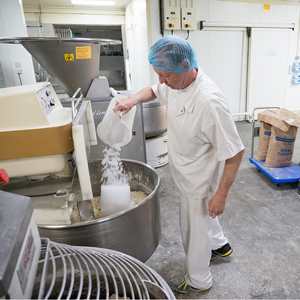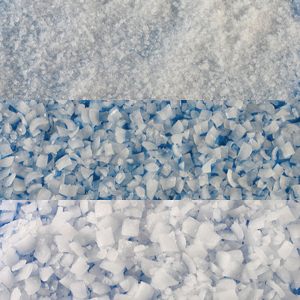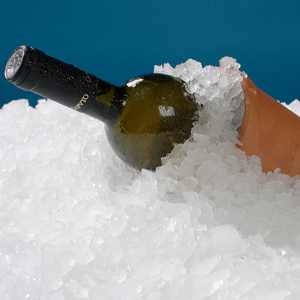| |
|
|
|
Thermostatic effect.
A drawback to mechanical refrigeration is that it can be uneven, often leading to product 'hot spots'. Ice is an effective way to regulate product temperature by uniform distribution around the product.
Products are often packed in ice even when stored and transported in refrigerated environments for this reason.
This effect is also seen when displaying goods in ambient environments such as shops and supermarkets. The air has to be warm for the comfort of the customers, so the ice protects the perishable goods from the warm air.
|
|
 |
| |
|
|
 |
|
Preventing damage from de-hydration
Dry refrigerated air can cause de-hydration to the surface of products which may cause unsightly damage in some cases.
As ice absorbs heat from the product, it slowly melts releasing a small, constant trickle of water over the product thuse proventing it from drying out in the low humidity refrigerated air.
|
| |
|
|
|
Hygienic
When the correct ice type is selected for the application and the water source is clean, cooling using ice can be very hygienic when used in tandem with good working practice.
Ice should always be treated as a foodstuff when using ice in a food production environment, particularly if the ice is to be used as an ingredient in a mix.
Find out more here.
|
|
 |
| |
|
|
|

|
|
Easy to Integrate
As previously stated, ice is relatively easy to store and move, thus making integration fairly straightforward.
The variety of types and sizes also means ice is easily adapted to a wide range of applications and industries.
Integration can be as simple as an elevated bin and cart system to a fully automatic ice plant that doses ice accurately into a process on demand.
|
| |
|
|
| Each ice type also has its own unique advantages |
| |
|
|
 |
|
Granular Flake ice
This type of ice is produced by the machine at an optimum temperature of -0.5°C so it acts as a good thermostat, maintaining products at around 0°C with no risk of partial freezing or freeze burn as its commonly known.
This temperature also means that the ice is not cold enough to re-freeze its own meltwater, so it always stays loose and friable when being stored and used in ambient conditions.
This ice type is available in three sizes
Micro - small pieces for gentle packing of delicate products and rapid cooling.
Midi - medium pieces for an all purpose ice with a good compromise between cooling rate and longevity
Macro - the largest piece size, up to 9mm thick for maximum longevity during long distance transport or for elevated temperatures.
Granular Flake ice machines are also have a single pass water system, which makes them intrinsically hygienic and suitable for food applications.
|
| |
|
|
|
Scale ice
This type of ice is what we refer to as a 'sub-cooled type' produced at around -7°C as it needs to be brittle enough to crack it from the drum. The cold temperature means that it is cold enough to re-freeze its own meltwater, so if allowed to melt during storage or use, it will begin to form large lumps that can be difficult to work with.
While the colder temperature does not give the ice any more cooling energy and can cause some problems at ambient temperatures, it does however mean that it can be stored below 0°C for longer term storage with no ill effects. This makes it ideal when ice is to be stored in a freezer.
While the multi-pass water system design of this type of machine makes maintaining a hygienic state more difficult, it does lend itself to large scale production so is ideal for large industrial projects where hygiene is not so important.
|
|
 |
| |
|
|
 |
|
StreamIce
StreamIce is available made from freshwater (SIF) or with the addition of a freezing point depressant such as salt (SI)
Freshwater StreamIce is a binary solution of small ice crystals and freshwater and is used mainly in food processing applications such as bakeries. It's excellent flow characteristics mean it can be pumped like water to the mixer and injected directly into the mix for highly accurate, repeatable and controllable results.
StreamIce is a binary solution of microscopic ice crystals and water with a freezing point depressant such as salt. This is usually used in niche applications such as ice pigging or specialised applications within the fishing industry.
Essentially they share the same construction with the Granular Flake ice machines, so are suitable for all food applications where hygiene is a high priority.
|
|
Nugget ice
This has broadly the same properties as Granular Flake ice, but with a slightly different shape, more like a mini cube than a flake.
A very versatile ice, often used in the food service sector for displaying food, cooling drinks and making cocktails etc. One machine can service many areas including a bar and restaurant for example.
|
|
 |
| |
|
|
| How does ice compare to other cooling methods |
| |
|
|
|
Chilled water
Chilled water is easily produced, stored and pumped to the desired location. However it is very low energy density so contains very little cooling per volume. It takes around 1kcal to raise 1 litre of water by 1°C, so if you wish to cool 100kg of product with a specific heat of 0.8 from 35°C to 5°C you would need 80litres of chilled water. However as the product neared its target temperature the cooling rate would be very slow.
On the other hand ice absorbs 70kcals of energy to melt, then it turns into a litre of chilled water at 0°C. This means you could chill the same 100kg of product in the scenario above using only 24kg of ice and the cooling rate would be much quicker. So less volume coolant for a faster result.
The big drawback with chilled water however comes when trying to directly cool products in a mixer. If the product above only had 40litres of water in the recipe, you cannot add 80litres of chilled water, so you would be unable to meet your targets. This would only get worse as temperatures increased during the warm summer months. Whereas it would be simple to just swap a little more of the recipe's water for a bit more ice to give year round control of the target temperature.
Carbon Dioxide and Liquid Nitrogen
The Delta T (difference in temperature) between cooling such as Carbon Dioxide or liquid Nitrogen and most products is usually very wide, so products can quickly become partially frozen and permanently damaged. The power required to manufacture these coolants is also much higher than that required to make ice, hence the cost is normally much higher. When adding in the complexity required to prevent product damage the system costs are often much higher than using ice.
If you would like some assistance with cooling using ice, please contact us with some details of your application.
|
| |
|
|
| |
|
|